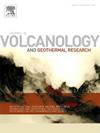Complex principal component analysis of volcanic earthquakes at Azuma volcano, Japan, recorded by a distributed acoustic sensing system (DAS) for the hypocenter determination
IF 2.3
3区 地球科学
Q2 GEOSCIENCES, MULTIDISCIPLINARY
Journal of Volcanology and Geothermal Research
Pub Date : 2025-04-11
DOI:10.1016/j.jvolgeores.2025.108343
引用次数: 0
Abstract
Distributed Acoustic Sensing System (DAS) can record ground motions with a measurement interval of a few to ten meters for a long-distance range of a few tens of kilometers. The sensor, which is a fiber-optic cable embedded underground, is protected from damage caused by lightning or pyroclastic materials. These features are useful for the seismic observation of active volcanoes. We analyzed DAS data recorded at the Azuma volcano, Japan, to determine the location of volcanic earthquakes and evaluate their reliability. Using the benefits of highly dense measurement points along the fiber optic cable, we applied complex principal component analysis (CPCA) to measure the arrival time differences of seismic waves from volcanic earthquakes. We used a relative hypocenter determination technique to accurately determine the source locations of the volcanic earthquakes recorded during our observation period in July 2019. We observed 148 small volcanic earthquakes and succeeded in determining 31 events with sufficient arrival time difference data. The obtained source locations were distributed around Jododaira, extending in the north-south direction with a length of approximately 2 km. These regions are consistent with the hypocenters determined from standard hypocenter determination using the arrival times of the P- and S-waves of volcanic earthquakes from 2017 to 2022. We also determine the source locations by using the arrival time difference measured by the cross-spectral method, which is often used in seismic wave analyses, and the number of located events is small and the obtained source locations are scattered. These results suggest that CPCA is useful for extracting signals from noisy raw seismic data and accurately measuring the arrival time difference for the source locations.
用分布式声传感系统(DAS)记录日本阿祖马火山地震的复杂主成分分析
分布式声传感系统(DAS)可以记录地面运动,测量间隔为几到十米,距离为几十公里。这种传感器是一种嵌入地下的光纤电缆,可以防止闪电或火山碎屑材料造成的损坏。这些特征对活火山的地震观测是有用的。我们分析了在日本阿祖马火山记录的DAS数据,以确定火山地震的位置并评估其可靠性。利用沿光缆高度密集测点的优势,应用复杂主成分分析(CPCA)方法测量火山地震地震波到达时差。我们使用相对震源确定技术准确确定了2019年7月观测期间记录的火山地震的震源位置。我们观测了148次小火山地震,成功地确定了31次事件,并获得了足够的到达时差数据。获得的震源位置分布在Jododaira周围,向南北方向延伸,长度约为2公里。这些区域与2017 - 2022年火山地震P波和s波到达时间标准震源确定的震源一致。我们还利用地震波分析中常用的交叉谱法测得的到达时差来确定震源位置,但所定位的事件数量少,得到的震源位置分散。这些结果表明,CPCA对于从有噪声的原始地震资料中提取信号和准确测量震源位置的到达时差是有用的。
本文章由计算机程序翻译,如有差异,请以英文原文为准。
求助全文
约1分钟内获得全文
求助全文
来源期刊
CiteScore
5.90
自引率
13.80%
发文量
183
审稿时长
19.7 weeks
期刊介绍:
An international research journal with focus on volcanic and geothermal processes and their impact on the environment and society.
Submission of papers covering the following aspects of volcanology and geothermal research are encouraged:
(1) Geological aspects of volcanic systems: volcano stratigraphy, structure and tectonic influence; eruptive history; evolution of volcanic landforms; eruption style and progress; dispersal patterns of lava and ash; analysis of real-time eruption observations.
(2) Geochemical and petrological aspects of volcanic rocks: magma genesis and evolution; crystallization; volatile compositions, solubility, and degassing; volcanic petrography and textural analysis.
(3) Hydrology, geochemistry and measurement of volcanic and hydrothermal fluids: volcanic gas emissions; fumaroles and springs; crater lakes; hydrothermal mineralization.
(4) Geophysical aspects of volcanic systems: physical properties of volcanic rocks and magmas; heat flow studies; volcano seismology, geodesy and remote sensing.
(5) Computational modeling and experimental simulation of magmatic and hydrothermal processes: eruption dynamics; magma transport and storage; plume dynamics and ash dispersal; lava flow dynamics; hydrothermal fluid flow; thermodynamics of aqueous fluids and melts.
(6) Volcano hazard and risk research: hazard zonation methodology, development of forecasting tools; assessment techniques for vulnerability and impact.

 求助内容:
求助内容: 应助结果提醒方式:
应助结果提醒方式:


